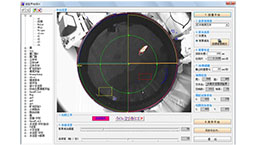Rat Model for Retinal Ischemia Reperfusion Injury (RIRI)
- Product No.DSI846Ra01
- Organism SpeciesRattus norvegicus (Rat) Same name, Different species.
- Prototype SpeciesHuman
- SourceAnterior chamber pressure perfusion
- Model Animal StrainsSD Rats(SPF), healthy, male, 6~8W ,body weight 180g~200g.
- Modeling Grouping1.Randomly divided into six group: Control group, Model group, Positive drug group and Tested drug group.
- Modeling Period1w
- Modeling Method1. Prepare for anesthesia: accurately weighing the weight of the rats and intraperitoneal injection of anesthesia rats;
2. The rats were placed on the operating table, and the right eye of the rats was disinfected with active iodine solution, and kept warm at 37℃.
3. Apply the eye anesthetic evenly to the eyeball.When there was no response that the cotton swab was touched to the eyeball of the rats, the needle of disposable intravenous infusion device was inserted into the middle and back vitreous from the sclera to stop the needle, and the eyeball was observed to change from red to colorless by sliding the flow regulator to the appropriate flow.Retinal ischemia began at this point, and the needle was removed 45 minutes later.During ischemia, care should be taken to stabilize the needle and continue anesthesia to prevent the needle from falling out or moving. - ApplicationsDisease Model
- Downloadn/a
- UOM Each case
- FOB
US$ 240
For more details, please contact local distributors!
Model Evaluation
After 72h of modeling, the animals were sacrificed, the retinal morphology was observed by HE staining, and the changes of Bcl-2 protein and Bax protein in retinal cells were detected by immunohistochemistry.
Results :HE staining showed that the retinal structure of normal control rats was clear and the cells of each layer were closely arranged. In the ischemia-reperfusion group, the retina is highly edematous with loss and disordered distribution of ganglion cells. A large number of Bcl-2 positive cells were observed in the retina of the normal control group, but decreased significantly in the ischemia-reperfusion group.
Pathological Results
Cytokines Level
Statistical Analysis
SPSS software is used for statistical analysis, measurement data to mean ± standard deviation (x ±s), using t test and single factor analysis of variance for group comparison, P<0.05 indicates there was a significant difference, P<0.01 indicates there are very significant differences.
GIVEAWAYS
INCREMENT SERVICES
-
 Tissue/Sections Customized Service
Tissue/Sections Customized Service
-
 Serums Customized Service
Serums Customized Service
-
 Immunohistochemistry (IHC) Experiment Service
Immunohistochemistry (IHC) Experiment Service
-
 Small Animal In Vivo Imaging Experiment Service
Small Animal In Vivo Imaging Experiment Service
-
 Small Animal Micro CT Imaging Experiment Service
Small Animal Micro CT Imaging Experiment Service
-
 Small Animal MRI Imaging Experiment Service
Small Animal MRI Imaging Experiment Service
-
 Small Animal Ultrasound Imaging Experiment Service
Small Animal Ultrasound Imaging Experiment Service
-
 Transmission Electron Microscopy (TEM) Experiment Service
Transmission Electron Microscopy (TEM) Experiment Service
-
 Scanning Electron Microscope (SEM) Experiment Service
Scanning Electron Microscope (SEM) Experiment Service
-
 Learning and Memory Behavioral Experiment Service
Learning and Memory Behavioral Experiment Service
-
 Anxiety and Depression Behavioral Experiment Service
Anxiety and Depression Behavioral Experiment Service
-
 Drug Addiction Behavioral Experiment Service
Drug Addiction Behavioral Experiment Service
-
 Pain Behavioral Experiment Service
Pain Behavioral Experiment Service
-
 Neuropsychiatric Disorder Behavioral Experiment Service
Neuropsychiatric Disorder Behavioral Experiment Service
-
 Fatigue Behavioral Experiment Service
Fatigue Behavioral Experiment Service
-
 Nitric Oxide Assay Kit (A012)
Nitric Oxide Assay Kit (A012)
-
 Nitric Oxide Assay Kit (A013-2)
Nitric Oxide Assay Kit (A013-2)
-
 Total Anti-Oxidative Capability Assay Kit(A015-2)
Total Anti-Oxidative Capability Assay Kit(A015-2)
-
 Total Anti-Oxidative Capability Assay Kit (A015-1)
Total Anti-Oxidative Capability Assay Kit (A015-1)
-
 Superoxide Dismutase Assay Kit
Superoxide Dismutase Assay Kit
-
 Fructose Assay Kit (A085)
Fructose Assay Kit (A085)
-
 Citric Acid Assay Kit (A128 )
Citric Acid Assay Kit (A128 )
-
 Catalase Assay Kit
Catalase Assay Kit
-
 Malondialdehyde Assay Kit
Malondialdehyde Assay Kit
-
 Glutathione S-Transferase Assay Kit
Glutathione S-Transferase Assay Kit
-
 Microscale Reduced Glutathione assay kit
Microscale Reduced Glutathione assay kit
-
 Glutathione Reductase Activity Coefficient Assay Kit
Glutathione Reductase Activity Coefficient Assay Kit
-
 Angiotensin Converting Enzyme Kit
Angiotensin Converting Enzyme Kit
-
 Glutathione Peroxidase (GSH-PX) Assay Kit
Glutathione Peroxidase (GSH-PX) Assay Kit
-
 Cloud-Clone Multiplex assay kits
Cloud-Clone Multiplex assay kits
| Catalog No. | Related products for research use of Rattus norvegicus (Rat) Organism species | Applications (RESEARCH USE ONLY!) |
| DSI846Ra01 | Rat Model for Retinal Ischemia Reperfusion Injury (RIRI) | Disease Model |






